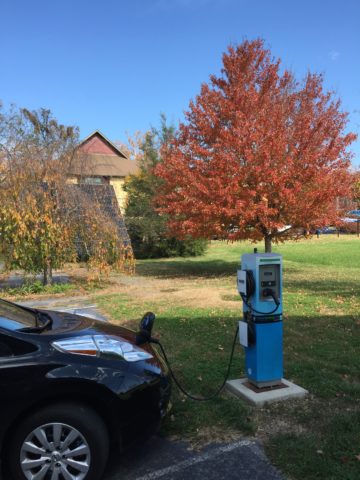This is the first in a series of blogs that will explore the various aspects of the quickly growing Electric Vehicle market and its implications on the transportation sector, energy sector, and carbon emissions as a whole.
 Nearly a decade after the original electric vehicle (EV) federal tax credit was created in 2010, federal incentives are starting to wane as manufacturers begin to meet the established quotas. Nonetheless, EVs are inarguably continuing to become more affordable, more practical, more dependable, more widespread, and more popular at an amazing pace. As plug-in hybrids and all-electric cars become more mainstream, these vehicles are poised to play a pivotal role in reducing carbon emissions nationally and globally, and play a key role in battling climate change, especially as the transportation sector has now taken over the electricity sector as the primary source of U.S. carbon dioxide emissions.
Nearly a decade after the original electric vehicle (EV) federal tax credit was created in 2010, federal incentives are starting to wane as manufacturers begin to meet the established quotas. Nonetheless, EVs are inarguably continuing to become more affordable, more practical, more dependable, more widespread, and more popular at an amazing pace. As plug-in hybrids and all-electric cars become more mainstream, these vehicles are poised to play a pivotal role in reducing carbon emissions nationally and globally, and play a key role in battling climate change, especially as the transportation sector has now taken over the electricity sector as the primary source of U.S. carbon dioxide emissions.
Having several years experience driving various EV models and watching the market closely, I’d like to share a few lessons learned and thoughts looking forward.
There are so many reasons to choose an EV, including some that are commonly misconceived – and many that go far beyond the obvious benefit of decreasing emissions. But one of the primary drivers for our support for the advancement of the market is the indisputable fact that, as we continue pressing for our country to move away from fossil fuels and embrace clean energy…
– EVs WILL Play a Key Role in Carbon Reduction –

As I reported in a previous blog, in 2018 overall power sector emissions remained at one of the lowest levels in the past 30 years. Petroleum emissions, however, continued to increase, with motor gasoline making up the bulk of this number. As coal reliance declines, and the electricity sector continues to turn to cleaner alternatives, our electric grid is becoming cleaner by the year, which inherently makes electric-powered vehicles cleaner as well. This stands in stark contrast to gas or diesel-powered vehicles, which become less efficient and more polluting by comparison with each passing year. EVs, then, can supply the missing link between a cleaner electric grid and lower overall emissions.
But there are countless other reasons that EVs are becoming more palatable for a larger market share. First and foremost…
It’s [becoming more and more] Affordable to Own; and is CHEAPER to Operate an EV
EVs are growing rapidly in number, variety, and market share. By the end of 2018, there were over 350,000 EVs on US roads (and over 3 million worldwide), at last look they accounted for 4.6% of global market share – which is nearly double that of the previous year. And along with this growth come steadily decreasing pricetags. Already today you can buy a brand new Tesla (yes, a Tesla) Model 3 for around $35,000 (after incentives), or a more moderate Chevy Bolt for under $30,000 (also after rebates andincentives). Those are admittedly still big numbers for many of us. But as prices continue to drop, there are more and more EVs on the road every year. And this growth is likely to continue, with some analysts claiming that by 2030 the number of EVs will be close to 125 million globally, and others projecting that EVs will make up 65% to 75% of US vehicle sales by 2050.
As EVs continue to take over market share, prices will continue to fall and used models will become more prolific, making the technology attainable for more consumers at lower costs. Meaning more and more of us could find ourselves with this view from the drivers seat:
Vehicle costs don’t just depend on sticker values either. EVs, in stark contrast to internal combustion engine (ICE) vehicles, have very little maintenance costs – for instance electric cars require no oil changes or transmission fluid, no maintenance for exhaust systems, no timing belts, and are much kinder to brake pads, minimizing brake maintenance. This phenomenon is described in detail by Forbes:
Gas-powered automobiles require replacing parts that go bad over time. Electric vehicles are different because they do not need as many components to operate. For instance, electric motors only have one moving part while engines in traditional automobiles contain dozens.
Not only does less maintenance save an EV driver money, but driving an EV also saves time. No more stopping at the gas station, and much less time spent driving to and from, and waiting for, scheduled maintenance and repairs.
So Stay tuned
In the coming weeks, I’ll be publishing additional articles explaining the various aspects of EV ownership and going into detail on the benefits, as well as the implications that this growing market is already having on customers, the automobile industry, and the utility sector. In the meantime, if you want to hear more about what SACE is doing to support the growth of the EV market and responsible utility choices that can benefit electric companies, consumers, and the environment as these trends continue, visit our website, check out my other recent post on EVs and CO2 reductions, and stay tuned for additional posts in this series digging deeper into some of the nuances surrounding EV market expansion.
